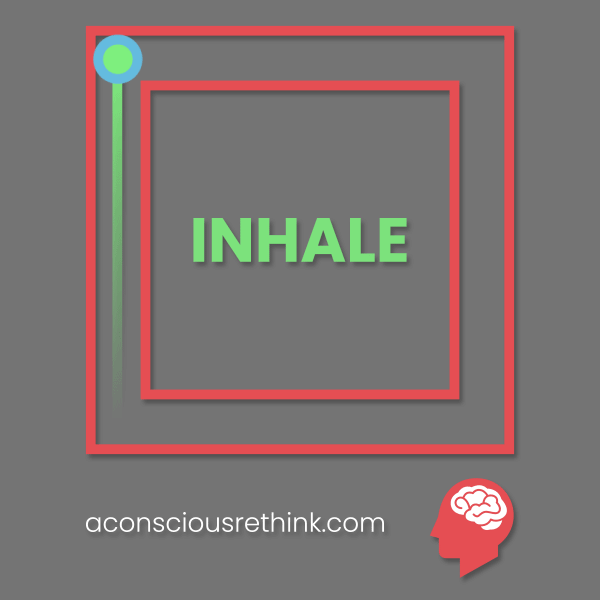Sometimes people get stuck living in their head rather than taking part in the life going on around them.
And chances are pretty good that you find it to be a problem if you’re reading this article.
You may find that you are missing opportunities, dwelling in anxiety and depression, or not progressing in your life as you want to be. Living inside your head creates difficult challenges for your life because you’re not as engaged as you need to be.
“Living in your head” can mean a couple of different things.
The first is “maladaptive daydreaming.” Maladaptive daydreaming is when a person uses their daydreams to escape an uncomfortable reality that they may be experiencing. It’s a habit that is often formed in childhood to cope with abuse or neglect. The child can’t stand up to their abuser head-on, change their situation, or force the abuser out of their life, so they escape into their daydreams. The problem is that it doesn’t just turn off as they get older. Instead, it becomes an unhealthy coping skill that can keep them from being present and engaged in the moment.
The second meaning is when people find themselves regularly trapped in their thoughts. For example, a person with anxiety may find that they are constantly worrying about what might happen in the future. They agonize over all the details, all the what-ifs, and try to make sense of the bad things that might happen in the future.
This can also be a problem for people with depression who may not necessarily be looking forward to anything because, y’know, depression. Instead, they may spend their time pining for a better past that is already gone. They may find themselves thinking more about times when they were happier and doing better.
There are a couple of significant problems with living in your head. Daydreaming your life away, agonizing over the future, or wishing for the past keeps you from living your life in the present where life is currently happening. You can’t predict the future nor change the past. Instead, you need to engage in the present to create the kind of life you want for yourself.
The other problem is that your thoughts are a closed loop. You aren’t gaining new information when you obsessively think about your life and situation. There comes a point where mindful consideration turns into unhealthy rumination where you are just going over and over the same thoughts. All that does is hurt you, stress you out, and make it harder to deal with whatever it is you’re trying to find an answer to.
None of this is exactly new or ground-breaking information. In fact, you’ll find that there are plenty of philosophies, religions, and belief systems that are looking for the answer to ground your mind in the present. That’s because living in your head is a problem that many people face now, then, and in the future.
The good news is that there are ways to deal with this problem, get out of your head, and get grounded back into the present. The bad news is that it will require time and effort. It may be a bigger problem than just trying to exert control over your thoughts. You may need to work on your trauma or get your mental health under control before doing it effectively.
Still, you may find some relief in these different methods of addressing the problem.
Speak to an accredited and experienced therapist to help you stop living in your head. You may want to try speaking to one via BetterHelp.com for quality care at its most convenient.
1. Practice grounding techniques.
Grounding techniques are often used to help people through acute mental health problems. For example, an anxiety or panic attack can be overwhelming and cause your mind to roam into extremes. The idea is to get one’s thoughts back into the present and grounded back into reality.
These same techniques can be helpful for people who find themselves lost in their own thoughts or daydreaming their life away.
There’s a simple grounding technique called 5-4-3-2-1. When you realize that you’re not in the present moment, do the following:
– Acknowledge 5 things that you can see.
– Acknowledge 4 things that you can touch.
– Acknowledge 3 things that you can hear.
– Acknowledge 2 things that you can smell.
– Acknowledge 1 thing that you can taste.
This technique forces your mind off of the harmful track that it is on. Unhealthy and anxious thought processes often roll forward like a train. It’s pretty easy to stop a train when it’s just starting to take off from its station. The train is slow-moving and doesn’t have any momentum built up yet. But, if the train is allowed to keep going, it will speed up and gain momentum, making it far more difficult to stop.
Unwell thoughts are much the same. Grounding techniques help disrupt the momentum those thought processes are building up. They help stop those thoughts before they spiral into something that can’t be easily controlled or stopped.
2. Learn to accept what you can’t control.
Many people who live in their heads are trying to control a situation they have no control over. They may constantly overthink because they try to rationalize their way around an inherently irrational situation.
For example, people. Why did this person do this? Why did this person do that? Why did they treat me this way? Why didn’t they do the right thing?
And really, the answer is very simple. Human beings are emotional creatures who often do things as a knee-jerk reaction to whatever emotions they are experiencing. And a lot of times, it’s just not rational or logical.
It just is what it is. They did a thing, not because they considered how it would affect other people around them, but because they felt an emotion and reacted to that emotion.
The same could even be said for people who live in their heads. Whatever they experience causes an emotional reaction, so they retreat into their mind to think about it or daydream their way around it instead of dealing with the problem or letting it go.
And sometimes, the situation isn’t that personal. Let’s say Gerald applies for a job that he really wants. It’s his passion in life, what he studied for, his absolute dream job. And he can’t stop thinking about it. Did he make any mistakes on his resume? Did he fill out the application correctly? What if they don’t call back? What if he doesn’t get hired? If he did get hired, this would be life-changing! He could afford to do the things that he wanted to do! He could have the kind of life that he wants to have! Everything could turn out so much differently! If only…
But hey, Gerald needs to slow his roll. It’ll likely be weeks before he hears anything back about the job. Gerald can more effectively use his time doing literally anything other than agonizing over the future. Whether he gets the job or not is entirely outside of his control. He needs to set that aside and focus more on his present until he hears back from the employer.
3. Work on observing your thoughts.
The idea behind observing your thoughts is to separate your thoughts from immediate emotional reactions.
For example, let’s say someone insults you for no reason. You’re on the job, and someone who is clearly having a bad day gets mouthy with you about something that’s entirely out of your control. The knee-jerk reaction to being insulted is often defensiveness.
This person is attacking you, so you need to dig in and prepare to defend yourself. Right? Your immediate reaction may be to fire back at that person angrily. After all, how dare they come at you when you’re just trying to live your life and do your job? How dare they assume they can just come out and attack you for no reason at all? You have to stand up for yourself! You can’t be a doormat! That’s what everyone says, at least.
But there is a choice there. You see, standing up for yourself doesn’t necessarily mean that you need to get angry and fire back. That can easily escalate a situation into something unmanageable. And escalating a person who doesn’t have the social acumen to act that way can be a questionable thing. What if they’re unstable? What if they’re high? What if they are somehow impaired in their ability to make the right decisions at the moment? Confrontation can escalate into violence, and no one wins.
Instead, we may need to take a few seconds to consider the situation before proceeding. Okay, this customer is angry and acting like a jerk. You can feel yourself getting angry because you’re being mistreated, but what are you going to do with that anger? Are you going to immediately throw it into the conflict? Or, can you instead just let yourself feel angry, but deal with the person to get them on their way?
To observe your thoughts is to not jump straight onto them and ride them to where they are going. Instead, a really easy thing you can do is just to wait about 10 seconds and think about what you’re feeling before you decide to do something.
In the context of living in your head, you may have this wave of anxiety and discomfort coming at you, but you may or may not be able to choose what you do with those emotions. You can dive into them and be pulled along by them, dwelling on all the possibilities and things that can go wrong. Or you can avoid doing that by involving yourself in a more present, positive coping skill.
One simple strategy that I personally use is a puzzle book. When I would feel those emotions trying to pull me away, I would sit down and do sudoku puzzles until the strength of the feelings had subsided more. So get yourself a word search, crossword, or sudoku puzzle book from the grocery store and focus on those when you find yourself getting pulled deep into your thought space.
4. Talk it out with a supportive person.
Talk it out with a supportive person. I specifically chose the words “supportive person” because some people aren’t in a place where they have friends or loved ones to lean on at the moment. You may also be surrounded by unhealthy people who can worsen the problem. Supportive people can be friends or loved ones, but they can also be members of a support group or a therapist.
The idea behind talking the situation out is to get yourself out of circular thinking. A person living in their head, absorbed in their own thought processes, will find themselves going in circles. It’s inevitable because you’re going to be thinking about the things that you already know or what you’re worried about.
Talking to another person helps disrupt that process because they can get you reoriented in a more forward direction. So it’s helpful to have another person say, “Okay, you already addressed that. Let’s get back on track.” That can be extremely helpful for training your brain to change directions when you need to.
This type of conversation will help you process the situation rather than ruminate and think in circles.
5. Interrupt those spirals with meditation.
Meditation is a powerful tool that can be used to interrupt circular thoughts. And guess what? It doesn’t have to be complicated! Not at all. We’ll use a simple technique called box breathing.
Inhale for four seconds, hold your breath for four seconds, exhale slowly for four seconds, hold your breath for four seconds, and repeat. And do that for just five minutes. Here’s a deep breathing GIF to help you visualize box breathing:

Here’s what will probably happen. Your brain will still be firing off thoughts about whatever it is you’re dealing with. You mentally say, “Okay. What is this?” You look at the thought, acknowledge it, and then you refocus your thoughts on your breathing. More thoughts will come; you do the same thing. You look at it, acknowledge it, and then let it go again.
The more you do it, the easier it will get. However, you may struggle with maintaining that kind of focus for whatever reason. For example, maybe you have ADHD or anxiety, and it’s really difficult for you to stay on a single track for any time at all. It may or may not help. If it’s that severe for you, you will want to get professional help to work on bringing that issue under control.
It’s perfectly normal to struggle with it. You’re not going to be a master at it by doing it two or three times. You just have to keep doing it. And the interesting thing, at least for me, is how much quieter things got in my head with meditation. Meditation can actually help forge new connections, which improves your brain’s ability to process things.
Aim for just five minutes.
6. Focus on other people for a while.
There’s an old saying that goes something to the effect of, “The best way to help yourself is to help others.” That can be kind of a loaded statement. Sometimes people use activities like helping other people to completely ignore and avoid their problems. That’s not good. That’s not healthy.
However, helping other people can provide a sense of purpose, give you something meaningful to focus on, and get you moving forward on your own path.
So many people struggle with a sense of self and purpose in this crazy world. It’s so much easier to find when you’re walking that path with other people. Serving other people can get you out of your mind and out of those circular thoughts.
It’s certainly not a replacement for dealing with the very real issues that many face. It’s not going to heal your trauma, control your mental illness, or anything like that. What it will do is give you something meaningful to think about as you step forward into that world and find a way to give back in a way that makes sense for you. It will also help you forge new friendships and relationships with people, leading to greater social support when you really need it.
Still, if you find yourself struggling with anxious thoughts, maladaptive daydreaming, or you just can’t keep yourself grounded in the present, it would be an excellent idea to talk about your situation with a mental health professional. They can provide tailored advice and mental techniques to bring yourself back to reality and face that reality, whatever it involves.
BetterHelp.com is a website where you can connect with a therapist via phone, video, or instant message.
While you may try to work through this yourself, it may be a bigger issue than self-help can address. And if it is affecting your mental well-being, relationships, or life in general, it is a significant thing that needs to be resolved.
Too many people try to muddle through and do their best to overcome issues that they never really get to grips with. If it’s at all possible in your circumstances, therapy is 100% the best way forward.
Here’s that link again if you’d like to learn more about the service BetterHelp.com provide and the process of getting started.
You’ve already taken the first step just by searching for and reading this article. The worst thing you can do right now is nothing. The best thing is to speak to a therapist. The next best thing is to implement everything you’ve learned in this article by yourself. The choice is yours.
You may also like:
- Break The Cycle Of Looping Thoughts By Rebooting Your Mind Like This
- How To Stop Daydreaming So Much: 6 Highly Effective Tips!
- How To Stop Ruminating: 12 Tips That Actually Work!
- How To Live In The Present Moment: 13 No Nonsense Tips!
- 12 Ways To Stop Thinking About Something










